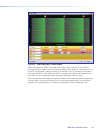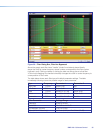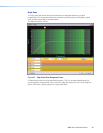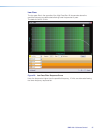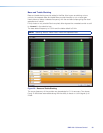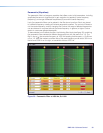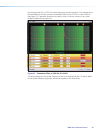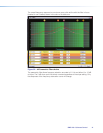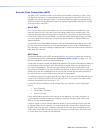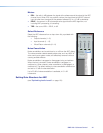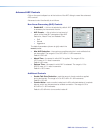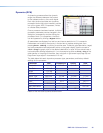
Acoustic Echo Cancellation (AEC)
The DMP128 C models provide one acoustic echo canceller processor for each of the
first eight mic/line inputs. A single reference can be selected for each AEC from a list of
the eight line outputs and virtual paths. The selected reference signal is compared to the
AEC input signal and the difference in gain is a decibel measurement reported via a meter
as an echo return loss (ERL).
About AEC
Echo occurs when audio from a talker in the far end is received and amplified into the
near end listener’s room, with that sound then being picked up by microphones in the
near end acoustic space and sent back to the far end. The amount of signal sent back
to the far end talker can be substantial, and with the added transmission delay, the result
is an echo effect that will seriously compromise communication in a teleconference or
videoconference.
The Acoustic Echo Cancellation processor removes the potential echo signal at the near
end mic channel by comparing it to the received signal from the far end, designated as
the “reference,” and then creating an adaptive filter to cancel the potential echo before it is
sent back to the far end.
AEC Setup
Successful operation of the AEC processing block is a function of proper gain structure
and selection of the AEC reference (see “Optimizing Audio Levels” on page101). This
section provides an overview of the two elements.
Proper gain structure involves the relationship between the signal at the selected reference
and the signal at the mic input, within the context of proper levels for the reference and
mic inputs independently. The mic input gain setting will naturally be optimized for the
voice level of the talker in that room; therefore the amount of signal from the far end that is
picked up by the mic is dependent on how much that far end signal is being amplified in
the near end room and the distance from the mic to the speakers.
The reference signal is the signal received from the far end, which will ultimately be sent to
a sound reinforcement system within the near end room. The output of the video codec
might be connected to any of inputs 9 – 12.
In the AEC dialog, a reference can be chosen from any channel in one of three signal
chains:
• Input Channels
• Virtual Return Channels
• Output Channels
Extron recommends using an input channel as the reference. An output channel or a
virtual channel may also be used as a reference; however, doing so adds a little more
delay to the signal being referenced.
Using an output or virtual channel reference allows for the combining of input channels
to a single reference, for instance, in a conferencing setup where both a telephone and
a video codec may be used in different instances. In this case, both the telephone and
video codec input channels can be routed to an output or virtual return, with that output
or virtual return then chosen as the reference.
DMP128 • Software Control 42



